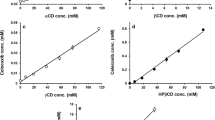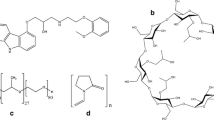Abstract
The aims of this study were (1) to prepare cinnarizine (CNZ)–β-cyclodextrin (β-CD) complexes by the kneading, co-precipitation and co-evaporation methods with (ternary system) or without (binary system) the addition of two different hydrophilic polymers [hydroxypropyl methylcellulose (HPMC) and polyvinylpyrrolidone (PVP)] in their two different grades (HPMC E5-LV or K4M and PVP K-25 or K-30) and (2) to determine the polymers influence on enhancing the CNZ solubility and the in vitro CNZ liberation behaviour or drug permeation characteristics via artificial membrane from the prepared CNZ–β-CD binary and ternary complexes in 0.1 N HCl (pH 1.2). The presence of hydrophilic polymers in ternary complex system did produce irregular-shaped but smooth-surfaced particles while binary complex system (with no polymer addition) did not. The ternary complexes prepared with HPMC K4M, β-CD and CNZ showed higher solubility efficiency value compared to other tested hydrophilic polymers to make ternary complex systems. Consequently, irrespective of the three preparation methods, the ternary complex systems exhibited higher drug libration behaviour in comparison to the binary complex system, physical mixtures and CNZ powder. But because of the possible presence of a solubility and permeability interplay or tradeoff particularly in the binary and ternary complex systems, the CNZ permeation amount in 0.1 N HCl (pH 1.2) via artificial membrane was established to a minimum compared to the CNZ powder. Therefore, the CNZ–β-CD complexes with or without the HPMC and PVP should unequivocally be used with great care by considering the solubility–permeability interplay or tradeoff into account.




Similar content being viewed by others
References
Terland O, Flatmark T (1999) Drug-induced parkinsonism: cinnarizine and flunarizine are potent uncouplers of the vacuolar H+-ATPase in catecholamine storage vesicles. Neuropharmacology 38(6):879–882
Singh BN (1968) The mechanism of action of calcium antagonists relative to their clinical applications. Br J Clin Pharmacol 21(Suppl 2):109–121
Nicholson AN, Stone BM, Turner C, Mills SL (2002) Central effects of cinnarizine: restricted use in aircrew. Aviat Space Environ Med 73(6):570–574
Peeters K, De Maesschalck R, Bohets H, Vanhoutte K, Nagels L (2006) In situ dissolution testing using potentiometric sensors. Eur J Pharm Sci 34:243–249
Jarvinen T, Jarvinen K, Schwarting N, Stella VJ (1995) Beta-cyclodextrin derivatives, SBE4-beta-CD and HP-beta-CD, increase the oral bioavailability of cinnarizine in beagle dogs. J Pharm Sci 84:295–299
Bergstrom CA, Wassvik CM, Johansson K, Hubatsch I (2007) Poorly soluble marketed drugs display solvation limited solubility. J Med Chem 50:5858–5862
Branchu S, Rogueda PG, Plumb AP, Cook WG (2007) A decision-support tool for the formulation of orally active, poorly soluble compounds. Eur J Pharm Sci 32:128–139
Gu CH, Rao D, Gandhi RB, Hilden J, Raghavan K (2005) Using a novel multicompartment dissolution system to predict the effect of gastric pH on the oral absorption of weak bases with poor intrinsic solubility. J Pharm Sci 94(1):199–208
Yamada I, Goda T, Kawata M, Ogawa K (1990) Application of gastric acidity-controlled beagle dog to bioavailability study of cinnarizine. Yakugaku Zasshi 110:280–285
Ogata H, Aoyagi N, Kaniwa N, Ejima A, Sekine N, Kitamura K, Inoue M (1986) Gastric acidity dependent bioavailability of cinnarizine from two commercial capsules in healthy volunteers. Int J Pharm 29:113–120
Larsen AT, Akesson P, Jureus A, Saaby L, Abu-Rmaileh R, Abrahamsson B, Østergaard J, Müllertz A (2013) Bioavailability of cinnarizine in dogs: effect of SNEDDS loading level and correlation with cinnarizine solubilization during in vitro lipolysis. Pharm Res 30(12):3101–3113. doi:10.1007/s11095-013-1145-x
Berlin M, Przyklenk K-H, Richtberg A, Baumann W, Dressman JB (2014) Prediction of oral absorption of cinnarizine—a highly supersaturating poorly soluble weak base with borderline permeability. Eur J Pharm Biopharm 88(3):795–806. doi:10.1016/j.ejpb.2014.08.011
Koumandrakis N, Vertzoni M, Reppas C. Increasing the biorelevance of simulated intestinal fluids for better predictions of drug equilibrium solubility in the fasted upper small intestine. In: 9th world meeting on pharmaceutics, biopharmaceutics and pharmaceutical technology, Lisbon, Portugal, 31 March–3 April, 2014
Rao S, Richter K, Nguyen TH, Boyd BJ, Porter CJH, Tan A, Prestidge CA (2015) Pluronics-functionalized silica-lipid hybrid microparticles: improving the oral delivery of poorly water-soluble weak bases. Mol Pharm 12:4423. doi:10.1021/acs.molpharmaceut.5b00622
Anby MU, Williams HD, McIntosh M, Benameur H, Edwards GA, Pouton CW, Porter CJH (2012) Lipid digestion as a trigger for supersaturation: evaluation of the impact of supersaturation stabilization on the in vitro and in vivo performance of self-emulsifying drug delivery systems. Mol Pharm 9(7):2063–2079
Vandecruys R, Peeters J, Verreck G, Brewster ME (2007) Use of a screening method to determine excipients which optimize the extent and stability of supersaturated drug solutions and application of this system to solid formulation design. Int J Pharm 342(1–2):168–175
Redenti E, Szente L, Szejtli J (2000) Drug/cyclodextrin/hydroxy acid multicomponent systems. Properties and pharmaceutical applications. J Pharm Sci 89:1–8
Mura P, Faucci MT, Manderioli A, Bramanti G (2001) Multicomponent systems of econazole with hydroxyacids and cyclodextrins. J Incl Phenom Macrocycl Chem 39:131–138
Higuchi T, Connors KA (1965) Phase solubility techniques. Adv Anal Chem Instrum 4:117–122
Affandi MMRMM, Tripathy M, Shah SAA, Majeed ABA (2016) Solubility enhancement of simvastatin by arginine: thermodynamics, solute-solvent interactions, and spectral analysis. Drug Design Dev Ther 10:959–969
Maragos S, Archontaki H, Macheras P, Valsami G (2009) Effect of cyclodextrin complexation on the aqueous solubility and solubility/dose ratio of praziquantel. AAPS PharmSciTech 10:1444–1451
Lamie NT, Monir HH (2016) Simultaneous determination of cinnarizine and dimenhydrinate in binary mixture using chromatographic methods. J Chromatogr Sci 54(1):36–42. doi:10.1093/chromsci/bmv103
Raghuvanshi S, Pathak K (2014) Recent advances in delivery systems and therapeutics of cinnarizine: a poorly water soluble drug with absorption window in stomach. J Drug Deliv. doi:10.1155/2014/479246 (Article ID 479246)
Lindfors L, Skantze P, Skantze U, Rasmusson M, Zackrisson A, Olsson U (2006) Amorphous drug nanosuspensions. 1. Inhibition of Ostwald ripening. Langmuir 22(3):906–910
Mehta DM, Parejiya PB, Barot BS, Shelat PK (2012) Investigation of the drug release modulating effect of acidifiers in modified release oral formulation of cinnarizine. Asian J Pharm Sci 7(3):193–201
Tran TT, Tran PH, Choi H, Han H, Lee B (2010) The roles of acidifiers in solid dispersions and physical mixtures. Int J Pharm 384(1–2):60–66
Gabr KE (1992) Effect of organic acids on the release patterns of weakly basic drugs from inert sustained-release matrix tablets. Eur J Pharm Biopharm 38(6):199–202
Tokumura T, Tsushima Y, Tatsuishi K, Kayano M, Machida Y, Nagai T (1987) Enhancement of the oral bioavailability of cinnarizine in oleic acid in beagle dogs. J Pharm Sci 76(4):286–288
Larsen AT, Ohlsson AG, Polentarutti B, Barker RA, Phillips AR, Abu-Rmaileh R, Dickinson PA, Abrahamsson B, Østergaard J, Müllertz A (2013) Oral bioavailability of cinnarizine in dogs: relation to SNEDDS droplet size, drug solubility and in vitro precipitation. Eur J Pharm Sci 48(1–2):339–350
Lee KW, Porter CJ, Boyd BJ (2013) The effect of administered dose of lipid-based formulations on the in vitro and in vivo performance of cinnarizine as a model poorly water-soluble drug. J Pharm Sci 102(2):565–578
Larsen AT, Ogbonna A, Abu-Rmaileh R, Abrahamsson B, Østergaard J, Müllertz A (2012) SNEDDS containing poorly water soluble cinnarizine; development and in vitro characterization of dispersion, digestion and solubilization. Pharmaceutics 4(4):641–665. doi:10.3390/pharmaceutics4040641
Kalava BS, Demirel M, Yazan Y (2005) Physicochemical characterization and dissolution properties of cinnarizine solid dispersion. Turk J Pharm Sci 2(2):51–62
Tokumura T, Ueda H, Tsushima Y, Kasai M, Kayano M, Amada I, Machida Y, Nagai T (1984) Inclusion complex of cinnarizine with β-cyclodextrin in aqueous solution and in solid state. J Incl Phenom Macrocycl Chem 2(3–4):511–521
Tokumura T, Nanba M, Tsushima Y, Tatsuishi K, Kayano M, Machida Y, Nagai T (1986) Enhancement of bioavailability of cinnarizine from its β-cyclodextrin complex on oral administration with dl-phenylalanine as a competing agent. J Pharm Sci 75(4):391–394
Tokumura T, Tsushima Y, Tatsuishi K, Kayano M, Machida Y, Nagai T (1986) Enhancement of the bioavailability of cinnarizine from its β-cyclodextrin complex on oral administration with l-isoleucine as a competing agent. Chem Pharm Bull 34(3):1275–1279
Hedges AR (1998) Industrial applications of cyclodextrins. Chem Rev 198:2035–2044
Loftsson T, Másson M, Brewster ME (2004) Self-association of cyclodextrins and cyclodextrin complexes. J Pharm Sci 93:1091–1099
Loftsson T, Magnúsdóttir A, Másson M, Sigurjónsdóttir JF (2002) Self-association and cyclodextrin solubilization of drugs. J Pharm Sci 91:2307–2316
Loftsson T, Másson M, Sigurjónsdóttir JF (1999) Methods to enhance the complexation efficiency of cyclodextrins. STP Pharma Sci 9:237–242
Loftsson T, Hreinsdottir D, Masson M (2005) Evaluation of cyclodextrin solubilization of drugs. Int J Pharm 302(1–2):18–28
Palani R, Kalavathy S (2011) Volumetric compressibility and transport studies on molecular interactions of mono, di and tri saccharides in aqueous sodium butyrate mixtures at 303.15 K. Adv Appl Sci Res 2:146–155
Şoica C, Gyeresi A, Dehelean C, Peev C, Aigner Z, Kata M (2008) Thin-layer chromatography as analytical method for inclusion complexes of some diuretics with cyclodextrins. Farmacia 56(1):75–82
Fernandes CM, Vieira MT, Veiga FJB (2002) Physicochemical characterization and in vitro dissolution behaviour of nicardipine β-cyclodextrins inclusion compounds. Eur J Pharm Sci 15:79–88
Beig A, Lindley D, Miller JM, Agbaria R, Dahan A (2016) Hydrotropic solubilization of lipophilic drugs for oral delivery: the effects of urea and nicotinamide on carbamazepine solubility–permeability interplay. Front Pharmacol 7:379. doi:10.3389/fphar.2016.00379
Dahan A, Beig A, Lindley D, Miller JM (2016) The solubility–permeability interplay and oral drug formulation design: two heads are better than one. Adv Drug Deliv Rev 101:99–107. doi:10.1016/j.addr.2016.04.018
Beig A, Agbaria R, Dahan A (2015) The use of captisol (SBE7-b-CD) in oral solubility-enabling formulations: comparison to HPβCD and the solubility–permeability interplay. Eur J Pharm Sci 77:73–78. doi:10.1016/j.ejps.2015.05.024
Beig A, Miller JM, Lindley D, Carr RA, Zocharski P, Agbaria R, Dahan A (2015) Head-to-head comparison of different solubility-enabling formulations of etoposide and their consequent solubility–permeability interplay. J Pharm Sci 104:2941–2947. doi:10.1002/jps.24496
Beig A, Agbaria R, Dahan A (2013) Oral delivery of lipophilic drugs: the tradeoff between solubility increase and permeability decrease when using cyclodextrin-based formulations. PLoS One 8:e68237. doi:10.1371/journal.pone.0068237
Dahan A, Miller J (2012) The solubility–permeability interplay and its implications in formulation design and development for poorly soluble drugs. AAPS J 14:244–251. doi:10.1208/s12248-012-9337-6
Dahan A, Miller JM, Hoffman A, Amidon GE, Amidon GL (2010) The solubility–permeability interplay in using cyclodextrins as pharmaceutical solubilizers: mechanistic modeling and application to progesterone. J Pharm Sci 99:2739–2749. doi:10.1002/jps.22033
Pavia DL, Lampman GM, Kriz GS, Vyvyan JR (2015) Introduction to spectroscopy, 5th edn. Cengage Learning Private Limited, New Delhi
Acknowledgements
The encouragement and support given by the management of Lovely Professional University, India, to perform this research work is acknowledged.
Author information
Authors and Affiliations
Corresponding author
Ethics declarations
Conflict of interest
The authors report no conflicts of interest to disclose.
Electronic supplementary material
Below is the link to the electronic supplementary material.

289_2017_2203_MOESM1_ESM.jpg
Supplementary Fig. 1. Thermograms obtained by differential scanning calorimetry (A) cinnarizine (CNZ), (B) β-cyclodextrin (β-CD), (C) HPMC K4M, (D) Physical mixture of ternary complexes made using HPMC K4M, β-CD and CNZ, (E) Ternary complexes prepared by Kneading method, (F) Ternary complexes made by co-precipitation method (Mid-point melting temperature and fusion enthalpy values are shown in Table 4) 1 (JPEG 250 kb)
Rights and permissions
About this article
Cite this article
Singh, H., Kumar, M., Gupta, S. et al. Influence of hydrophilic polymers addition into cinnarizine–β-cyclodextrin complexes on drug solubility, drug liberation behaviour and drug permeability. Polym. Bull. 75, 2987–3009 (2018). https://doi.org/10.1007/s00289-017-2203-z
Received:
Revised:
Accepted:
Published:
Issue Date:
DOI: https://doi.org/10.1007/s00289-017-2203-z




